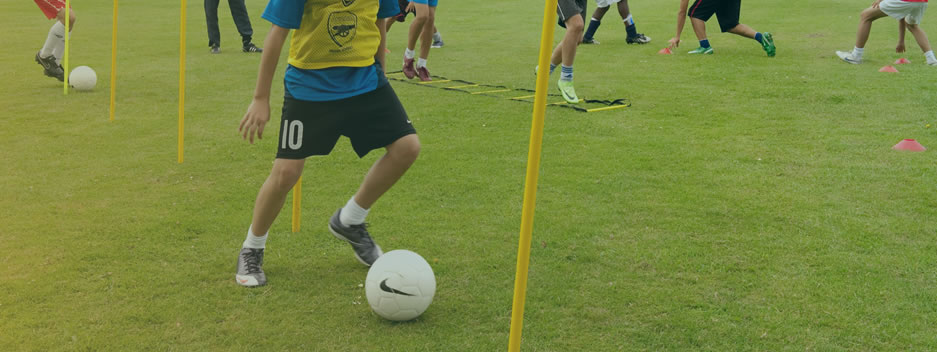5 Tips to Encourage Creativity
- April 3rd, 2019
- Tom Bean

In sport, finding hidden patterns, generating ideas and implementing them to solve problems is a vital part of the game. In the field of play, individuals are faced with ever-changing challenges to overcome - to achieve this they must have the capacity to be creative.
Creativity - 'the act of turning new and imaginative ideas into reality.'
A creative player is often considered to have the tricks, the skills, the awareness to make a splitting pass; however, creative qualities of varying forms exist in every player.
Generating the ideas is imaginative, communicating them effectively is creative. That can be in the form of an inventive finish, having the spatial awareness to make a searching pass or the social awareness to motivate and lead teammates; therefore, each individual has the potential to generate ideas and impact performance.
The 3 forms of creativity:
Solo
The individual has the intelligence and skill to be able to pull off audacious skills to overcome hurdles.
Spatial
The individual has the spatial awareness to give others a platform to perform. They recognise space on the field or court and how the team can exploit it.
Social
The individual has the social awareness to appreciate its impact on performance. They use this to communicate and develop relationships to give others the confidence and knowledge to perform
The challenge for us as coaches is to elicit each individuals creativity every time they take to the field of play. So how do we need to coach to help them express themselves?
5 Tips to Generate Creativity
'Express Yourself' Sessions
Introduce sessions or practices within sessions that solely focus on creativity to overcome a hurdle. During the practice, the only goal is to solve the problem by expressing their creativity with new skills and/or certain movements to create space and get a positive outcome.
Within the practice, players need the freedom to try new skills and approaches without fear of failure. The aim is to build problem solving skills and an assurance in their own ability so not to fear obstacles in a game.
For example, for game based sports, put a player in a box, surrounded on all sides by a defender. They must be imaginative to think of a way out and creative to implement it effectively. Whether it's done with a specific skill or a fast change in movement, allow them the freedom to work it out themselves however they see fit.
Punish Recklessness, Not Failure
There is a fine balance between creativity and recklessness. Players, particularly young ones, can see creativity as a license to over-complicate things, oftent to the detriment of performance.
In its simplest form, creativity is having an idea and communicating it to overcome a problem - if the best idea is a simple one, that's what should be encouraged.
Therefore as a coach, it's important to punish over-complication when in a simple situation and conversely to not punish failure when attempting to be creative in a tough situation.
Problem-Solving Activities
Social creativity is the skill of communicating effectively with teammates to overcome problems. By taking the players away from the sporting arena and instead giving them problem-solving tasks out of sport, you will develop how they interact.
Classic tasks like the marshmallow-spaghetti tower forces individuals to discuss how to overcome the issue and manage relationships. In the new environment, they will have to be creative with how they communicate, perhaps delegating roles and making smaller teams to do different parts etc.
On the field, this will help them understand how to communicate more effectively with eachother to overcome issues, generating new ideas of ways to interact to get the best from the team.
Don't Settle for Understanding
During sessions, it's easy to settle on having your players understanding certain tactics and play. Sometimes this is important to the way the team plays and ultimately the result.
However, making practices too controlled takes the thinking out of the process and limits players scope to be creative. This leads to a lack of skills needed to solve problems themselves.
Therefore, try to incorporate drills with less restrictions, that are opposed and encourage some thought as to how to complete it, rather than giving them the answer straight away.
By coaching to understand, players will become unstuck in game play with the situation isn't the same as to how it was set up at training - it leaves them lacking the creativity to come up with and try new ideas.
Change the Rules
Changes to the environment forces creativity. A great way to do this is to adjust the rules and see what creative ideas the team comes up with to overcome the hurdles that are in their way.
For example, in hockey, football and netball, adopting rugby 'only passing backwards' rule will instigate a new thought process for the players to work out how to advance up the pitch without passing forwards.
It will work all parts of their creativity - their solo skills, their spatial and social awareness - to be able to construct a plan and implement it in play.
To develop players and teams that are able to handle challenges and solve problems of their own accord, you must allow creativity the opportunity to prosper.
As a coach, you must recognise the different forms in which creativity is shown and help players discover their potential to overcome difficult situations by striking a balance between creativity and over-complication.
Use these tips and take inspiration from Sportplan to help establish a creative mindset amongst your players.